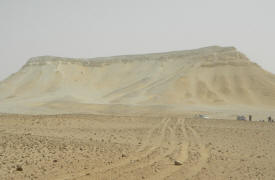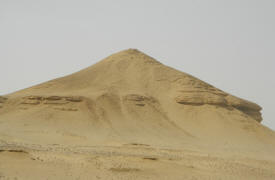|

by April Holloway
17 July, 2013
from
Ancient-Origins Website
Substantial evidence has
emerged confirming that
mysterious structures found by
an amateur satellite archaeologist
are a series of long-lost
pyramids in the Egyptian desert.
The pyramid-like structures were
first spotted last year by
Angela Micol, who noticed the huge mounds against a flat desert
plain on Google Earth.
However, despite gaining widespread
media attention at the time, her claims were highly criticized and
she was met with huge resistance from so-called experts who refused
to accept that such an incredible discovery could be made by a
layperson sitting at a computer in Northern California.
"They would be the greatest pyramids
known to mankind," said Medhat Kamal El-Kady, former ambassador
to the Sultanate of Oman, and his wife Haidy Farouk Abdel-Hamid,
a lawyer, former counselor at the Egyptian presidency.
"We would not exaggerate if we said
the finding can overshadow
the Pyramids of Giza."
'Authoritative' geologists and
geo-archaeologists initially dismissed the structures as windswept
natural rock formations, a justification we see time and again when
incredible discoveries are made which could rewrite the history
books, such as the Bosnian pyramids.
However, preliminary investigations as well as evidence emerging
from unlikely sources have provided substantial evidence to support
the claim that the ‘Google anomalies’ are actual a series of ancient
pyramid complexes.
The two possible pyramid complexes appear as groupings of
mounds with interesting alignment.
One site in Upper Egypt, just 12 miles
from the city of
Abu Sidhum along the Nile, features
four mounds while the site 90 miles north near
the Faiyum oasis,
displays a four-sided, truncated mound approximately 150 feet wide
and three smaller mounds in a diagonal alignment.
A ground proofing expedition at the site near Abu Sidhum has now
revealed cavities and shafts under the buried mound and what appears
to be a temple or habitation site near the pyramid and a row of what
may be
mastaba tombs adjacent to the mounds.
A metal detector also revealed an
underground tunnel heading north and the presence of metal - could
it be a buried tomb with gold and other treasures?
Most Egyptian pyramids also have north
facing entrance tunnels.
"Those mounds are definitely hiding
an ancient site below them," Mohamed Aly Soliman, who led the
preliminary expedition near Abu Sidhum.
"The mounds are different: You will
find pottery everywhere, seashells and transported layers. These
are different layers, not belonging to the place, and were used
by the Egyptians to hide and protect their buried sites," he
said.
The discovery of seashells is
particularly interesting considering that the pharaohs used
seashells to build their tombs and in the pyramids for ventilation
purposes.
However, supporting the findings from the ground investigation is
evidence that has emerged from an unlikely source - a series of
ancient maps and documents which show pyramids in those exact sites.
Medhat Kamal El-Kady and Haidy Farouk Abdel-Hamid are
top collectors of maps, old documents, books and rare political and
historical manuscripts.
After the initial media hype last year
following the discovery on Google Earth, the Egyptian couple contact
Angela Micol to say that had important historical references for
both sites.
In fact, the two exact sites in Fayum
and near Abu Sidhum were both labeled as pyramid complex sites
in several old maps and documents. In total, there are 34 maps and
12 old documents that refer to the pyramids.
Several of the documents point to the existence of two buried
pyramids which add to the known Fayum pyramids of
Lahoun and
Hawara. Their sources indicate the
pyramids at the Fayum site were intentionally buried in a "damnatio
memoriae" - an attempt to intentionally strike them from
memory.
The emergence of the old maps and documents together with the
initial ground investigations provide strong evidence that the
mysterious mounds are in fact long lost pyramids in Egypt. If this
is the case, it could be the archaeological find of the century.
Further investigations are taking place to explore the sites and we
will be reporting back with news as it emerges.
|
 |
 |
 |
|
Are
these formations in the Egyptian desert long lost
pyramids? Or are they just naturally occurring pyramidal
rock outcrops?
The structures were spotted last year by amateur
satellite archaeologist Angela Micol. She used Google
Earth 5,000 miles away in North Carolina.
|
Located about 90 miles apart, the two possible pyramid
complexes appeared on aerial imagery as an unusual
groupings of mounds with intriguing orientations.
One site near the Fayum oasis revealed a four-sided,
truncated mound approximately 150 feet wide and three
smaller mounds in a diagonal alignment (left).
The other site, just 12 miles from the city of Abu
Sidhum along the Nile, featured two large and two small
mounds (right). |
First reported by Discovery News, Micol’s claim gained
widespread media attention and much criticism.
Authoritative geologists and geo-archaeologists
dismissed what Micol called “Google Earth anomalies” as
windswept natural rock formations - buttes quite common
in the Egyptian desert.
|
|
 |
 |
 |
|
Micol was then contacted by an Egyptian couple --
collectors who claimed to have important historical
references for both sites.
According to Medhat Kamal El-Kady, former ambassador to
the Sultanate of Oman, and his wife Haidy Farouk Abdel-Hamid,
a lawyer, former counselor at the Egyptian presidency
and adviser of border issues and international issues of
sovereignty, more than 34 maps and 12 old documents in
their collection would support the existence of the lost
pyramids. |
For
the site near the Fayum, they cited three maps in
particular, dating from 1753 to the late 1880s.
The documents would point to the existence of two buried
pyramids (within the red square) which add to the known
Fayum pyramids of Lahoun and Hawara.
|
While the site in the Fayum has not been investigated
yet, a preliminary on-the-ground expedition has already
occurred at the site near Abu Sidhum.
According to Micol, it provided intriguing data to
compare with El-Kady and Farouk’s maps and documents.
|
|
 |
 |
 |
|
Suspecting the mounds were ancient in origin, locals
tried to dig into one of the two smaller mounds.
|
The
excavation failed due to striking very hard stone that
Aly and Micol believe may be granite.
|
Aly
Soliman believes the big mounds are hiding pyramids as
the metal detector used over them signaled metal and
showed an underground tunnel heading north. |
|
 |
 |
|
Apart from the two larger and smaller mounds, the
expedition team believes the site features a temple or
habitation and a row of what may be mastaba tombs
adjacent to the mounds. They are shown in the red
rectangle thanks to a false color imaging technique
developed by Micol. |
“My
goal is to go to Egypt with a team of U.S. scientists
and videographers to prove if these sites are lost
pyramid complexes,” Micol said.
|
|











